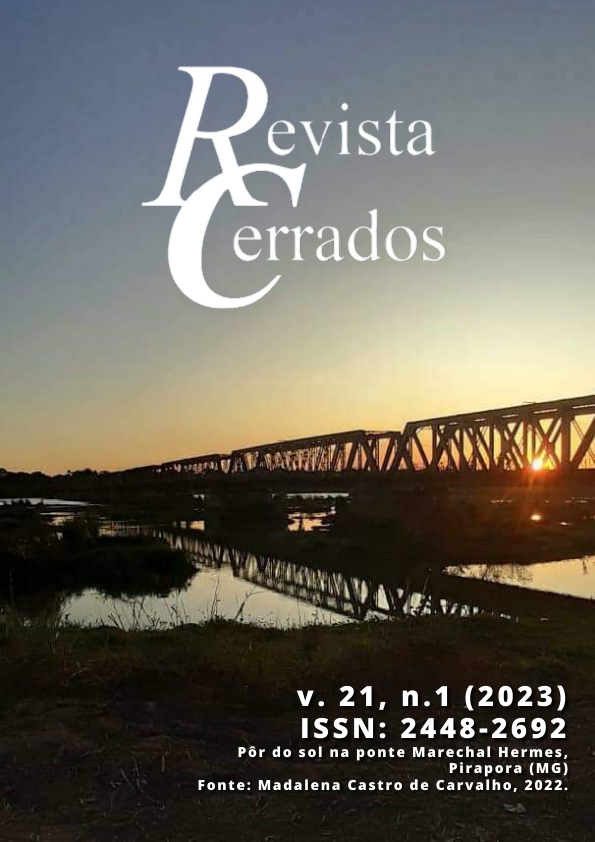Regional Development through the Lens of Geographical Indications in Northeast Brazil
DOI:
10.46551/rc24482692202306Palavras-chave:
Desenvolvimento regional, Indicações Geográficas, Nordeste brasileiroResumo
Regional development is directly linked to the historical evolution of communities and the occupation of their territories, as well as the current state of the occupied or explored spaces, and their economic dynamics. In this sense, knowing that discussions on regional development are crucial, one should note that geographical indications (GIs) can contribute to its achievement. Therefore, this paper aims at investigating the relations between geographical indications and the regional development of Brazil’s Northeast, seeking to understand if there has been any relevant development in the region since the granting of GIs. By adopting a qualitative and quantitative approach, including bibliographic study, documentary analysis, and data survey through questionnaires applied to representatives of the 16 current geographical indications in the Northeast, we observed that there was, in fact, regional development after the certification of these GIs, especially concerning the valorization of manufacturers, products, and locations. However, it was also evident that there is a need for restructuring, mainly of the GIs that are not using the stamp. It is of the utmost importance to establish a partnership between public and private institutions, associations, and manufacturers to strengthen and integrate the actors of different production chains, generating a kind of development guided by the balance between economic, environmental, social, and cultural benefits.
Downloads
Referências
ALMEIDA SILVA, A.; DA SILVA, G. F. Potencialidades para Obtenção de Indicação Geográfica na Rota do Vinho do Vale do São Francisco. Revista Cerrados, [S. l.], v. 19, n. 02, p. 403–426, 2021.
ALMEIDA SILVA, A.; RODRIGUES, B.; DA SILVA, G. F. Breve panorama das Indicações Geográficas do Nordeste brasileiro e reflexões sobre os negócios locais. Informe GEPEC, [S. l.], v. 26, n. 1, p. 238–256, 2022.
BOISIER, S. Modernidad y territorio. Santiago de Chile: ILPES, 1996.
BRASIL, Portaria INPI/PR nº 04 de 12 de janeiro de 2022. Estabelece as condições para o registro das Indicações Geográficas, dispõe sobre a recepção e o processamento de pedidos e peções e sobre o Manual de Indicações Geográficas. Disponível em: <https://www.in.gov.br/en/web/dou/-/portaria/inpi/pr-n-4-de-12-de-janeiro-de-2022-375778644>. Acesso em: 30 abr. 2022.
BRUCH, K. L.; VIEIRA, A. C. P. Glocal: a indicação geográfica como forma de proteção aos conhecimentos tradicionais. PIDCC: Revista em propriedade intelectual direito contemporâneo, [S./l.], v. 10, n. 2, p. 91-107, 2016.
CIRIBELLI, M. C. Como elaborar uma dissertação de Mestrado através da pesquisa científica. Rio de Janeiro: 7 Letras, 2003.
CORRÊA, J. C. S.; SILVEIRA, R. L. L.; KIST, R. S. B. Sobre o conceito de desenvolvimento regional: notas para debate. Revista Brasileira de Gestão e Desenvolvimento Regional, [S./l.], v. 15, n. 7, p. 3-15, 2019.
DI BLASI, G. A propriedade industrial: os sistemas de marcas, patentes e desenhos industriais analisados a partir da Lei nº 9.279, de 14 de maio de 1996. Rio de Janeiro: Forense, 2005.
FAJARDO, S. Algumas discussões sobre a abordagem econômica do território na geografia e suas implicações no espaço rural. Revista RA'EGA, Curitiba, n. 10, p. 131 - 137, 2005.
FURTADO, C. Desenvolvimento e subdesenvolvimento. Rio de Janeiro: Contraponto: Centro internacional Celso Furtado, 2009.
FURTADO, C. Formação econômica do Brasil. São Paulo: Ed. Nacional, 1966.
GIL, A. C. Como elaborar projetos de pesquisa. 6. ed. São Paulo: Atlas, 2019.
INPI, Instituto Nacional da Propriedade Industrial. Indicações Geográficas. 2020. Disponível em: <https://www.gov.br/inpi/pt-br/servicos/perguntas-frequentes/indicacoes-geograficas>. Acesso em: 30 abr. 2022.
INPI, Instituto Nacional da Propriedade Industrial. Pedidos de Indicação Geográfica no Brasil. 2022. Disponível em: <https://www.gov.br/inpi/pt-br/servicos/indicacoes-geograficas/pedidos-de-indicacao-geografica-no-brasil>. Acesso em: 25 abr. 2022.
ITC, INTERNATIONAL TRADE CENTER. Guide to Geographical Indications: Linking Products and Their Origins. United Nations. Geneva, Switzerland. 2009. 232 p. Disponível em: <https://www.intracen.org/Guide-to- Geographical-Indications-Linking-Products-and-their-Origins/>. Acesso em: 29 abr. 2022.
KITCHENHAM, B.; CHARTERS, S. Guidelines for performing Systematic Literature Reviews in Software Engineering. Technical Report EBSE 2007-001, Keele University and Durham University Joint Report, 2007.
LIMA, A. C. C.; SIMÕES, R. F. Teorias clássicas do desenvolvimento regional e suas implicações de política econômica: o caso do Brasil. Revista de Desenvolvimento Econômico, [S./l.], v. 12, n. 21, p. 5-19, 2010.
LIMA, J. F. O Espaço e a Difusão do Desenvolvimento Econômico Regional. In: PIACENTI, C.; LIMA, J. F.; EBERHARDT, P. H. (Org.). Economia e desenvolvimento regional. Foz do Iguaçu: Parque Itaipu, 2016. 204 p.
MATTAR, F. N. Pesquisa de marketing. 3. ed. São Paulo: Atlas, 2001.
MCCLELLAND, J. A. G. Técnica de questionário para pesquisa. Revista Brasileira de Física, [S./l.], v. 1, n. 1, p. 93-101, 1976.
MENDONÇA, D.; PROCÓPIO, D. P.; SANTOS CORRÊA, S. R. A contribuição das indicações geográficas para o desenvolvimento rural brasileiro. Research, Society and Development, [S./l.], v. 8, n. 7, p. 1-18, 2019.
MENEGAZ, F. File: Brazil Labelled Map.svg. 2007. Disponível em: <https://commons.wikimedia.org/w/index.php?curid=2231836>. Acesso em: 20 abr. 2022.
OLIVEIRA, L. Ranking Médio para escala de likert. Metodologia Científica e Técnicas de Pesquisa em Administração. Mestrado em Adm. e Desenvolvimento Organizacional. Varginha: PPGA CNEC/FACECA, 2005.
OLIVEIRA, N. M. Revisitando algumas teorias do desenvolvimento regional. Informe GEPEC, [S./l.], v. 25, n. 1, p. 203-219, 2021.
OLIVEIRA, O. F.; LIMA, J. F. Desenvolvimento regional diferenciado no Seridó brasileiro. Revista de Economia Regional, Urbana e do Trabalho, [S./l.], v. 10, n. 1, p. 129-150, 2021.
OMPI, Organização Mundial da Propriedade Intelectual. Convenção que institui a Organização Mundial da Propriedade Intelectual. 2002. Disponível em: <https://www.wipo.int/edocs/pubdocs/pt/wipo_pub_250.pdf>. Acesso em: 30 abr. 2022.
PELLIN, V. Indicações Geográficas e desenvolvimento regional no Brasil: a atuação dos principais atores e suas metodologias de trabalho. Interações (Campo Grande), Campo Grande, v. 20, n. 1, p. 63-78, 21 mar. 2019.
RODRIGUES, W. Capital Social e Desenvolvimento Regional no Brasil. Revista Brasileira de Gestão e Desenvolvimento Regional, [S./l.], v. 14, n. 1, p. 43 - 60, 2018.
SANTOS, N. A. A valorização e diferenciação do produto rural por meio das indicações geográficas e marcas coletivas. 2021. Disponível em: <https://bityli.com/XDgYOz>. Acesso em: 12 abr. 2022.
SEBRAE, Serviço Brasileiro de Apoio às Micro e Pequenas Empresas. Entenda o conceito de indicação geográfica. 2017. Disponível em: <https://www.sebrae.com.br/sites/PortalSebrae/artigos/entenda-o-conceito- de-indicacao-geografica,5a8e438af1c92410VgnVCM100000b272010aRCRD>. Acesso em: 30 abr. 2022.
SILVA JUNIOR, S. D.; COSTA, F. J. Mensuração e Escalas de Verificação: uma Análise Comparativa das Escalas de Likert e Phrase Completion. PMKT – Revista Brasileira de Pesquisas de Marketing, Opinião e Mídia, São Paulo, Brasil, v. 15, p. 1-16, out. 2014.
SOUZA, W. C. A indicação geográfica dos artefatos de couro em Ipirá/Bahia: Instrumento possível de desenvolvimento territorial. 2016. 149 f. Dissertação (Mestrado em Geografia) - Universidade Federal da Bahia, Salvador, 2016.
TEIXEIRA, A. L. F. Q. Indicações geográficas e desenvolvimento regional: o caso do algodão colorido da Paraíba. 2017. 69 f. Dissertação (Programa de Pós-Graduação em Desenvolvimento Regional - PPGDR) - Universidade Estadual da Paraíba, Campina Grande – PB, 2017.
TRIVIÑOS, A. N. S. Introdução à pesquisa em Ciência Social: a pesquisa qualitativa em educação. São Paulo: altos, 1987.
VANIN, C. E. Propriedade Intelectual: conceito, evolução histórica e normativa, e sua importância. 2016. Disponível em: <https://duduhvanin.jusbrasil.com.br/artigos/407435408/propriedade-intelectual-conceito-evolucao-historica-e-normativa-e-sua-importancia>. Acesso em: 30 abr. 2022.
WHITE, S. A. Introduction to BPMN.IBM Software Group. 2006. Disponível em: <http://www.omg.org/news/meetings/workshops/soa-bpm-mda-2006/00-T4_White.pdf>. Acesso em: 30 abr. 2022.
XAVIER, T. R., WITTMANN, M. L., INÁCIO, R. O.; KERN, J. Desenvolvimento regional: uma análise sobre a estrutura de um consórcio intermunicipal. Revista de Administração Pública, [S./l.], v. 47, p. 1041-1066, 2013.
Downloads
Publicado
Como Citar
Licença
Copyright (c) 2023 Revista Cerrados

Este trabalho está licenciado sob uma licença Creative Commons Attribution-NonCommercial-NoDerivatives 4.0 International License.
Nesta Revista, os Direitos Autorais para artigos publicados são do(s) autor(es), sendo os direitos da primeira publicação pertecentes à Revista Cerrados. Os artigos são de acesso público, de uso gratuito, de atribuições próprias, de atribuições educacionais e de aplicações não comerciais.


















